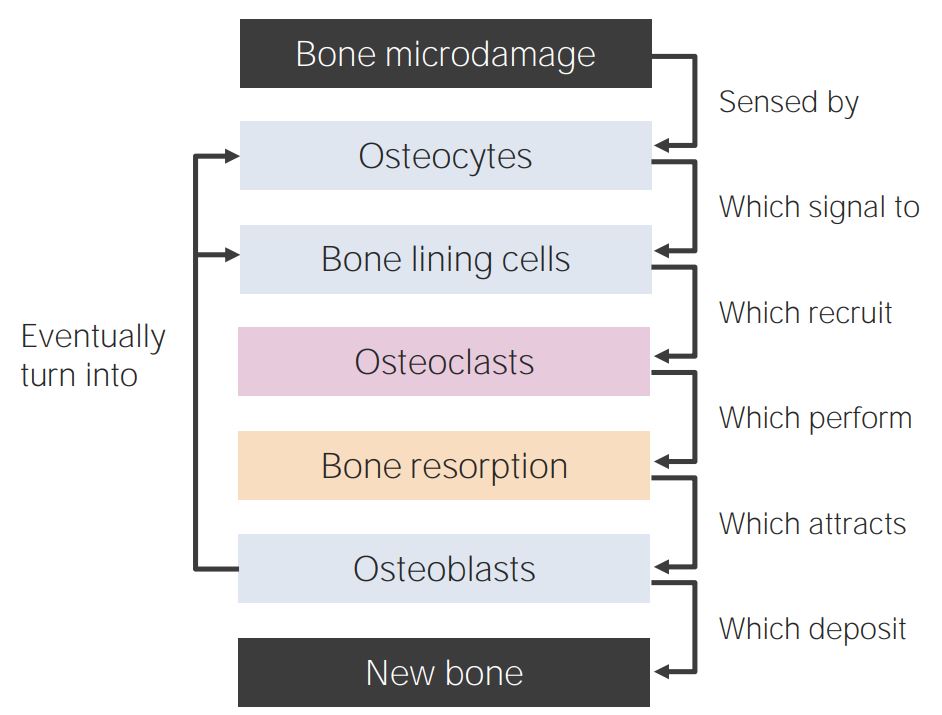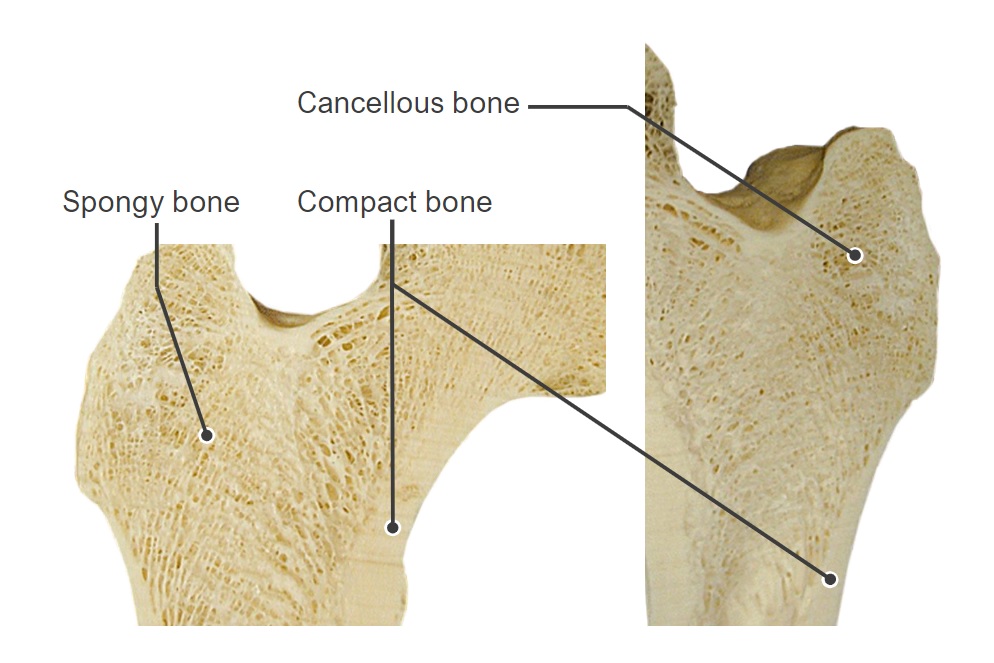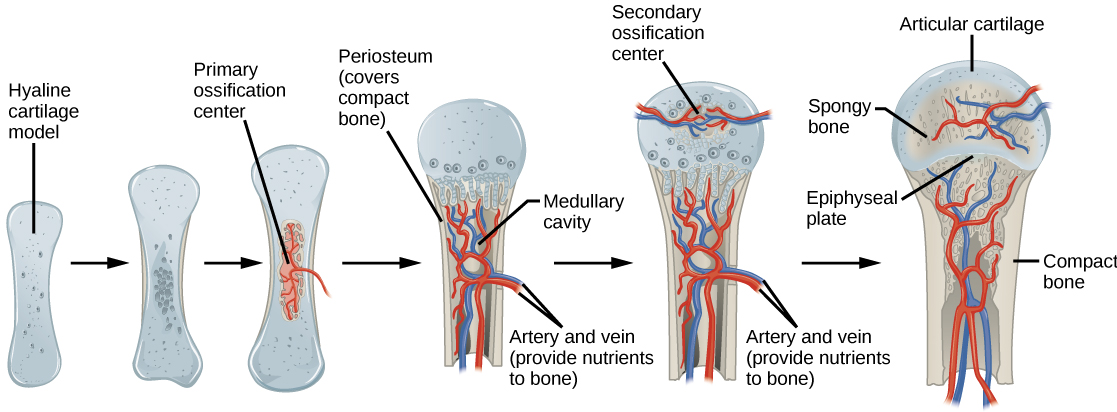Playlist
Show Playlist
Hide Playlist
Bone Remodeling
-
Slides 01 Bone MusculoskeletalSystem.pdf
-
Download Lecture Overview
00:01 Bone remodeling. 00:03 This is probably our most important clinical aspect of bone. 00:09 Bone will remodel to three primary things. 00:13 One is bone microdamage, which we’ll use in your example. 00:17 Stress on the bone will also cause bone remodeling. 00:22 And what do I mean by stress? It simply has to have the amount of torque on the bone. 00:28 The other one that can do bone remodeling are hormones: parathyroid hormone and calcitonin. 00:35 Let’s now move to our example of bone microdamage causing remodeling. 00:42 The first thing that happens is this bone microdamage is sensed by osteocytes. 00:49 Osteocytes are located deeper within the bone and these structures or cells will sense the microdamage has occurred. 00:59 They then signal another cell known as bone lining cells. 01:05 It is this bone lining cells that get the process started of remodeling. 01:12 They will recruit osteoclasts, and osteoclasts are the type of bone cell that break down current bone. 01:23 We then get bone resorption occurring and recruit osteoblasts to that particular area. 01:32 Osteoblasts lay down new bone. 01:36 Once that new bone is deposited or laid down, what happens to those osteoblasts? They can either be trapped within the bone and become osteocytes or they turn into bone lining cells. 01:52 So this is the process that we’re going to step through. 01:56 Now let’s take each one of these processes in greater detail so we understand the mechanisms behind bone remodeling which is so important for us clinically. 02:09 The first step that we’ll review here is what happens to the initial signal. 02:15 Remember, osteocytes need to signal bone lining cells. 02:20 How does it do that? Well, it senses that there might have been microdamage that has occurred. 02:26 This microdamage oftentimes sense these osteocytes into apoptosis, which is a programmed cell death of the osteocyte. 02:37 The bone lining cells sense that apoptosis occurring. 02:44 These bone lining cells then do a couple of things. 02:47 The first thing they do is send out chemoattractants. 02:52 These chemoattractants will bring other cells into closer proximity to where this locale is of microdamage. 03:02 The second thing it does is the bone lining cells start to disassociate from the bone surface. 03:10 This creates a little bit of a pocket. 03:14 Those chemoattractants will bring other cells to it, and the cells that it’s trying to attract are osteoclasts. 03:24 Osteoclasts will be brought to this particular area by those attractant molecules. 03:32 They then go with inside the pocket that has been created by those bone lining cells. 03:40 It is also attracted, at that same time, osteoblast precursor cells. 03:46 So we have osteoclast precursors then osteoblast precursors. 03:50 The osteoclast precursors have a specialized receptor known as a RANK receptor and the osteoblast precursors have a rank ligand or RANKL. 04:03 These two things fit together and these cells then form big groups of cells by merging together. 04:13 They all do this under the cover of a bone lining kind of pocket. 04:20 This protects these cells and gives a local environment for them to do their job, but keeps them separate now from the other portions of the circulation. 04:35 These large cells that have come together and form these large multinucleated osteoclasts are going to be the primary breaker down of bone, and they do that with enzymes, and they will start to liberate both calcium and phosphate. 04:58 They will simply dig a hole in the bone by dissolving it away. 05:06 Once they have done their job in dissolving that bone, they will be terminated and osteoblasts will be recruited to the area to start filling in that new bone. 05:20 Osteoblasts do this bone remodeling portion. 05:25 Interestingly, some osteoblasts will be trapped within the matrix. 05:31 These trapped osteoblasts will eventually become osteocytes. 05:37 The osteoblasts continue to make new bone until they have filled in the area that was dug out by the osteoclasts. 05:48 Then these new cells, these osteoblasts, can turn into new bone lining cells and this completes the process. 05:59 And you might think to yourself why undergo bone remodeling? That is a lot of work, right? You are undergoing bone remodeling right now, all the time. 06:11 In fact, they say as a young adult you might be remodeling about 20% of your bone per year, an older adult maybe 2% to 4% is constantly being remodeled. 06:23 So this process occurs throughout the body in many different bones. 06:29 This microdamage though will occur specifically in certain bones that have undergone some sort of trauma. 06:36 So you can have this in trauma bones or even in regular bones that are undergoing normal stress. 06:42 And that is one of the reasons why you get larger bone mineral densities when you’re younger as you’re remodeling more than when you’re older and you start to lose some of that bone mineral density. 06:56 Now, I said that there were three main components or factors that recreated remodeling to occur: microdamage, which we covered; stress on the bone; and the third were the hormones. 07:10 So now let’s go through the hormonal aspects of controlling the amount of blood levels of calcium and phosphate.
About the Lecture
The lecture Bone Remodeling by Thad Wilson, PhD is from the course Musculoskeletal Physiology.
Included Quiz Questions
Which receptor do osteoclast precursors use to bind osteoblast precursors?
- RANK
- M cholinergic
- Beta-1-adrenergic
- Alpha-2-adrenergic
- GLUT-2
Which of the following is one of the main drivers of bone remodeling?
- Bone microdamage
- Emotional stress
- Intake of milk
- Immune suppression
- Intake of vitamin C
Which of the following cells is the first to sense microdamage?
- Osteocytes
- Osteoblast
- Osteoclast
- Osteoclast precursors
- Hematopoietic stem cells
Which of the following cells play the role of the first messenger to chemoattractants in the bone remodeling cycle?
- Bone lining cells
- Osteocytes
- Osteoblasts
- Osteoclasts
- Hematopoietic bone marrow cells
Which of the following is the first event in the bone remodeling cycle?
- Signal microdamage
- Activation
- Osteoclast precursor recruitment
- Absorption
- Deposition
Which of the following cells forms the bone-lining cell layer?
- Osteoblasts
- Osteocytes
- Osteoclasts
- Osteoblast precursors
- Osteoclast precursors
Customer reviews
4,0 of 5 stars
| 5 Stars |
|
1 |
| 4 Stars |
|
0 |
| 3 Stars |
|
1 |
| 2 Stars |
|
0 |
| 1 Star |
|
0 |
explained very well and clear in short time. got all i need to know
In my opinion, this course on muscles is good for a review of the most important points of the topic. I couldn't find the striated muscle lecture, there are only smooth muscle lectures here. I think a little bit of more detail could make this course perfect!







